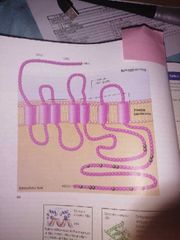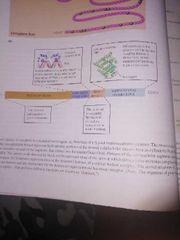![]()
![]()
![]()
Use LEFT and RIGHT arrow keys to navigate between flashcards;
Use UP and DOWN arrow keys to flip the card;
H to show hint;
A reads text to speech;
34 Cards in this Set
- Front
- Back
- 3rd side (hint)
|
What are receptors |
Specific protein in the plasma membrane or interior of target cell that a chemical messager binds with invoking a response in that cell |
Target cell protein |
|
|
Chemical messager |
Is a ligand |
The receptor is the binding site of it |
|
|
What activates and changes the receptors tertiary structure (conformation) |
The binding of the messenger to the receptor |
|
|
|
What are the two types of Receptors |
1. Plasma membrane receptors 2. Intracellular receptor |
|
|
|
What is the sequence that leads after activation |
1. Cells leading 2. Cells response 3. Messager called signal transduction Signal - receptor activation Transduction - process where stimulus is transformed into a response |
|
|
|
What is the nature that binds intracellular chemical messager |
(Glyco) - Proteins in the cells plasma membrane |
Most common location |
|
|
Why is in the cells plasma membrane more common then inside the cell (cytosol or nucleus) |
Cause larger number of messagers are water soluble and cannot diffuse across lipid rich (hydrophobic) plasma membrane In contrast smaller number of messengers diffuse to bind to their receptors located inside the cell |
|
|
|
Plasma Membrane Receptor |
Are transmembrane Proteins and they spam the entire membrane thickness |
Trans |
|
|
Characteristics of plasma membrane |

1. Has hydrophobic segments within membrane 2. One or more hydrophilic segments extend out from membrane into extracelluler fluid 3. Other hydrophilic segments extend out from membrane to intracellular fluid 4. Arriving chemical messagers bind to extracelluler parts of Receptors 5. Intracellular regions of Receptors are involved in signal transduction events 6. Can tranduce signals without interacting with DNA
|
Water fearing Water loving Extention from membrane to extra and intra Arriving bind Regions involved to messager ( ST)
|
|
|
Characteristics of Intracellular Receptors |

1. Not located in membrane but exist in the cytosol or cell nucleus 2. Have a very different structure 3. They have segments that binds to messager and other act as regulatory sites 4. Segments bind to DNA 5. Transducer signals through interactions with genes |
|
|
|
What are the Key distinctions between the two types of Receptors |
Plasma Membrane Receptors--can transduce signals without interacting with DNA Intracellular Receptors- transduce signals through interactiona with genes |
|
|
|
What are the four features that define the interactions between receptors and their ligands |
1. Specificity 2. Affinity 3. Saturation 4. Competition |
SASC |
|
|
Specificity |
Ability of a receptor to bind only one type or a limited number of structurally related types of chemical messagers
🗒 Only cells that express the correct receptors can bind a particular messanger |
|
|
|
What happens when cell types posses receptors with the same messager |
The responses of various cell types to that messager may differ from each other |
|
|
|
Affinity |
The degree/strength to which a chemical messenger binds to its receptors |
Degree of binding m to r |
|
|
A receptor with a high affinity will bind with a messenger with a what |
It will bind with a messenger with a lower concentration and vice versa 🗒 Affinity differences are NB for therapeutic drugs 🗒 Receptors with high affinity for a ligand requires less of the ligand (lower dose) to become activated |
|
|
|
Saturation |
Degree to which receptors are occupied by messengers |
Degree of occupancy r to m |
|
|
1. How fully are receptors saturated if all is occupied 2. How fully are receptors saturated if half is occupied |
1. 100%-saturated 2. 50%-saturated |
|
|
|
With saturation what are the cells response to messenger and why is the response like that |
The cells response to messenger increases as extracelluler concentration of messager increases, it is beacause the number of receptors occupied by messenger molecules increases |
|
|
|
Competition |
Ability of molecules to compete with natural ligand for binding to its receptors |
Compete NL with R |
|
|
How does competition occur |
It occurs with messenger with similar structures (underlies action of drugs) |
|
|
|
What would you do to interfere with the action of a particular messenger |
Administer competing molecules with similar structure to endogenous messenger that they bind to |
|
|
|
What happens if competing molecules differ in structure from ligand |
They can bind to receptor but cannot activate it. Without activation endogenous messenger are blocked from binding and doesn't induce a signal transduction / trigger cells response |
|
|
|
Antagonist |
Molecule that competes with ligand for binding to its receptor but doesn't activate signaling |
|
|
|
Agonist |
Chemical messenger that binds to a receptor and trigger cells response |
|
|
|
Name the two types of Regulations of Receptors |
* Up-regulation * Down-regulation |
|
|
|
What is Down-regulation |
A decrease in the total number of target cell receptors for a given messenger ;may occur in response to chronic high extracelluler concentration of the messenger (maintained for some time) |
|
|
|
What are the effects of Down-regulation |
Reducing target cells responsiveness to frequent /intense stimulation by messenger (desensitizing them) thus represents local negative feedback machanism |
|
|
|
How is Down-regulation possible? |
Possible because it has a continuous synthesis and degradation of receptors |
|
|
|
What is the main mechanism of Down-regulation of plasma membrane? |
Internalization |
|
|
|
1.What stimulates internalization and 2. what are the requirements/restrictions of it? 3.What is the consequences of it? |
1. Binding of messenger to receptor stimulate internalization 2. Only if messenger - receptor complex is taken into cell by receptor - mediated endocytosis 3. It increases the rate of receptor degradation inside the cell. Consequently @increased concentrations the number of plasma membrane receptors of that type gradually decreases during Down-regulation |
|
|
|
What is Up-regulation |
An increase in the total number of target cell receptors for a given messenger ;may occur in response to a chronic low extracelluler concentration of the messenger (is prolonged for some time) |
|
|
|
What happens when cells are exposed for a prolonged period to veryow concentration of a messenger |
The cells may have many more receptors for that messenger thereby developing increased sensitivity to it |
|
|
|
Fill in the following The 1._________ the number of 2.__________ available to bind a 3.__________, the 4. ___________ the likehood that such binding will occur. |
1. greater 2. receptors 3. ligand 4. greater |
|

